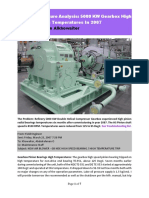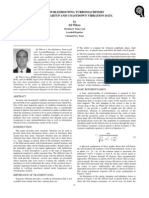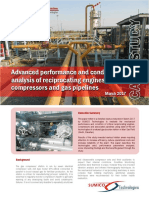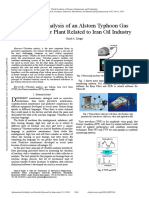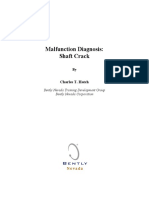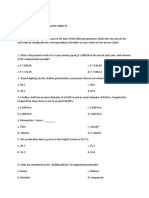058467
058467
Uploaded by
Marco BertoldiCopyright:
Available Formats
058467
058467
Uploaded by
Marco BertoldiOriginal Description:
Copyright
Available Formats
Share this document
Did you find this document useful?
Is this content inappropriate?
Copyright:
Available Formats
058467
058467
Uploaded by
Marco BertoldiCopyright:
Available Formats
Dynamic Pressure Monitoring in Gas Turbines
An Exploration into Gas Turbine Working Principles, Monitoring Techniques, and Cost Savings
Summary
The need to meet tougher emissions targets and to improve gas turbine reliability and performance means that engines undergo many improvement programs and run with ever-leaner fuel / air mixtures. These changes can lead to instabilities and excessive pressure pulsations that can result in mechanical failure. Piezoelectric sensor technology is available to measure these dynamic pressures directly. Moreover, commercially available on-line condition monitoring techniques can provide early warning of problems. The avoidance of mechanical repair costs, downtime costs, and environmental fines can produce savings measured in millions of dollars. This article examines the technology employed in the dynamic pressure measurement process.
Chris G. James SKF Dymac Adriaan J. L. Verhage KEMA 18 pages November 2002 SKF Reliability Systems @ptitudeXchange 4141 Ruffin Road San Diego, CA 92123 United States tel. +1 858 244 2540 fax +1 858 244 2555 email: info@aptitudexchange.com Internet: www.aptitudexchange.com
Use of this document is governed by the terms and conditions contained in @ptitudeXchange.
Dynamic Pressure Monitoring in Gas Turbines
Introduction......................................................................................................................................3 Overview of Gas Turbines ...............................................................................................................3 Improvements in the Process ....................................................................................................5 Common Problems ...................................................................................................................5 Reduction of Emissions ............................................................................................................6 Combustion Monitoring...................................................................................................................6 Costs/Benefits ...........................................................................................................................6 Combustion Chambers..............................................................................................................6 The Dynamic Pressure Sensor ..................................................................................................7 Indirect Method ........................................................................................................................8 Direct Method...........................................................................................................................8 Example Installation .................................................................................................................9 Signal Processing....................................................................................................................10 Spectral Banding.....................................................................................................................11 Case examples................................................................................................................................12 Process Conditions..................................................................................................................12 Cracking in Combustors .........................................................................................................12 Combustor Resonance #1 .......................................................................................................13 Combustor Resonance #2 .......................................................................................................14 Cardiograms...................................................................................................................................15 Visualization Tools.................................................................................................................16 Conclusion .....................................................................................................................................18 About Dymac and KEMA .............................................................................................................18 References......................................................................................................................................18
2002 SKF Reliability Systems All Rights Reserved
Dynamic Pressure Monitoring in Gas Turbines
Introduction
Combustion instabilities in industrial gas turbines can produce intolerably large pressure waves, which lead to fatigue, detachment of components, and costly outages and repair. The measurement of dynamic pressure amplitudes within the combustion chamber may be used in condition monitoring analyses to detect and correct instabilities before they cause serious damage. However, the technical challenge in physically measuring dynamic pressure directly - within the very high temperature environment of the gas turbine combustion chamber - is a significant one. This article examines the technology employed in the dynamic pressure measurement process, and reviews the means and benefits of generating a "cardiogram" for the gas turbine combustor during regular service. First, a brief overview of the gas turbine process is covered to provide context and explain terminology for readers unfamiliar with gas turbine engineering.
Then, it covers the general background for the use of Dynamic Pressure monitoring (also called Pressure Pulsation), together with a cost / benefit discussion to justify further investigation. A discussion of the measurement process leads to an illustration of analysis of the measurements within the complete system of a gas turbine, using the analysis software Flamebeat.
Overview of Gas Turbines
A simplified schematic of the basic gas turbine is shown in Figure 1. A gas turbine is divided into two main components: the Gas Generator (GG) and Power Turbine (PT). The GG is made up of one or more spools, each consisting of a compressor, shaft, and turbine. The fundamental thermodynamic cycle is like that of any combustion engine - draw in air, compress it, mix it with fuel in a combustion chamber, ignite the compressed fuel / air mixture and exhaust the gas. Some of the
Figure 1. General diagram of a gas turbine. Airflow is from left to right. The general process is that the air is drawn in, compressed, mixed with fuel in a combustion chamber, ignited, and then the compressed fuel / air mixture is exhausted through a turbine. The end result is energy that is used to drive or propel a machine.
2002 SKF Reliability Systems All Rights Reserved
Dynamic Pressure Monitoring in Gas Turbines energy from the exhaust gas stream is absorbed by the spool turbine, thereby completing the engine cycle by turning the compressor to draw in more air. The power turbine, the rotation of which converts the thrust energy of the gas into rotational energy to turn the driven machine, absorbs the majority of the energy. The remaining hot gas is exhausted to atmosphere or to another process. Although the applications of gas turbines are many, there are a certain number of common aspects to allow for classifications. The first possible classification is the mode of drive: Direct drive from the power turbine to the driven components. Geared drive (speed reduction or increase). Offshore - e.g. export gas compressors. On-board - e.g. main propulsion for ships.
The large variety of gas turbines available have the above common class features. However, there is a broader grouping that is helpful when considering vibration monitoring and condition monitoring of gas turbines. This broader classification focuses on whether the gas turbine under consideration is an "Aeroderivative" or a "Heavy Duty Industrial." Aeroderivatives are light in construction as they are derived from aircraft engines. They lend themselves to offshore and shipboard applications. Aeroderivatives have a vast array of possible configurations, and operate in a power range broadly between 10 MW to 50 MW. Heavy Duty Industrial range from 10 MW to well above 100 MW, and the heavy construction of this type of gas turbine naturally predisposes them for stationary applications, such as onshore power generation.
The next possible classification can be made as a function of rotational speed: Operation at constant speed - e.g. turboalternators. Operation at variable speed - e.g. turbopumps or turbo-compressors.
Finally there is the consideration of physical location: On-shore - e.g. refineries, pipelines, power plant.
The smaller units use rolling element bearings, the medium ones have a mix of rolling element and journal (plain) bearings, and the heavy ones use almost exclusively journal bearings.
2002 SKF Reliability Systems All Rights Reserved
Dynamic Pressure Monitoring in Gas Turbines
Figure 2. This figure contains several key marker areas: 1 - area in which the rolling element or journal bearings reside. 2 - the front end of the compressor section. 3 - cannular or annular combustion chambers. 4 - front end of the turbine section. 5 exhaust chamber. 6 exhaust nozzle.
Improvements in the Process The introduction of advanced heavy industrial gas turbines, such as GE Power System's FRAME-type series, and SiemensWestinghouse's W501G, has been far from trouble-free. In 1999-2000, a survey of 5000 power plants in North America (by POWERdat) found that the average capacity factor for combined cycle plants ranged from 42% to 52% in their first three months of operation. Over the years, gas turbine manufacturers have achieved impressive improvements in output, thermal efficiency and emissions by implementing a series of modification programs, including: Higher firing temperatures Scaled-up rotors Cooling schemes (steam cooling) Use of exotic alloys Cutting edge aerodynamics
Common Problems The previous availability numbers show that these improvements have, in the early days at least, frequently come at the expense of the operations and maintenance budget, with problems, such as: Rotor vibration "Humming" Failed turbine blades and nozzles Compressor disk cracking Vibrations of front compressor diaphragms Combustor high frequency dynamics
Manufacturers introduced combustor design improvements to: Reduce combustion oscillations Reduce emissions 5
2002 SKF Reliability Systems All Rights Reserved
Dynamic Pressure Monitoring in Gas Turbines Reduction of Emissions Environmental legislation across the globe is striving for reduced emissions from all industries. Harsh financial penalties will be incurred by utilities that do not meet the set targets. Proposed standard in the European Union for NOx emissions from gas turbines greater than 50 MW capacity is 43 g/GJ (50 mg/Nm3 in 15% O2, dry flue gas). Many local authorities already impose this limit as a daily averaged emission limit prior to granting permission for building new combined cycle power generation units. Many existing utilities with gas turbine generation were built to conform to previous stateenforced limits of 65 g/GJ (75 mg/Nm3 in 15% O2, dry flue gas) or greater. Thus, to avoid future penalties, the utilities are faced with implementing measures to reduce their NOx emissions. Production of NOx occurs in the combustion process of the gas turbine. The temperature of the flame is related to the amount of NOx generated: the lower the flame temperature, the lower the emissions. However, the thermodynamics of the engine cycle demand the highest temperature possible to achieve maximum efficiency. The amount and quality of the fuel (usually natural gas) also influences the emissions level. The most common solution is a combination of a flat temperature profile with "lean" fuel mixtures to achieve the best compromise between efficiency and permitted emissions. However, the drawback of this approach is flame instability. Flame instability can produce pressure waves (or pulsations), which may lead to fatigue, and, if too large in amplitude, possible failure of combustion chamber components. The pulsations are continuously variable pressure amplitudes that behave like, and are coupled to, acoustic and vibration phenomena, and may be measured as dynamic pressure. This leads us to the use of condition monitoring techniques using dynamic pressure measurements to provide early warning of conditions that can lead to excessive pulsation amplitudes.
Combustion Monitoring
Costs / Benefits Before discussing the technical implementation of condition monitoring of combustors, we first confirm the economic driver for implementing such a system. The cost of implementing an on-line condition monitoring system for combustion dynamics varies depending on the gas turbine quantity and type. The cost of dynamic pressure sensors, signal processing equipment, analysis software, and analysis expertise is approximately $150,000 to $300,000 USD initially, plus ongoing consultancy support. The cost of repairs to gas turbines cost more than downtime and weigh heavily on maintenance budgets. For example, the cost of a single new turbine blade alone can be $30,000 USD. However, when one blade fails, it has consequential damage that takes many others with it. Combustion chamber failures can have similar implications. A damaged chamber needs to be replaced, and debris from a cracked chamber could enter the turbine and damage many blades. Net result is that a repair bill from any single incident is frequently several million dollars. Avoiding such failures and omitting the cost of downtime and possible fines from increased emissions is an obvious financial motivator.
2002 SKF Reliability Systems All Rights Reserved
Dynamic Pressure Monitoring in Gas Turbines Combustion Chambers There are two possible combustion chamber (or combustor) geometry configurations (Figure 3): Annular Cannular compressor air and introduce it into the combustor, where it is ignited. The resultant flame is confined to the single can. The hot gas flow is then channelled to the first stage of the turbine via a transition piece, where it joins the flow from the other cans located around the circumference. The Dynamic Pressure Sensor As with all measurement systems, the sensor is the critical factor for success, as the most sophisticated and expensive processing hardware and software technology available is made useless if the input signal is unreliable and inaccurate. The greatest obstacle in actually measuring the dynamic pressure is achieving stable characteristics over the entire temperature range present in the combustion chamber at the pick-up point (typically 400C). Two approaches are available today: Indirect Measurement Direct Measurement
An annular combustor is a hollow annulus (or ring) wrapped around the circumference of the engine. A series of burners, located at equal intervals around the ring, mix fuel with compressor air and introduce it into the combustor, where it is ignited. The resultant flame is a continuous ring. The annular hot gas flow is then channelled to the first stage of the turbine. A can-type, or cannular configuration is a series of individual, can-shaped combustors placed around the circumference of the engine. Each can has a series of burners located on its cover. These mix fuel with
Figure 3. The two basic configurations for a combustion chamber: annular and cannular. The method to achieve the combustion varies slightly based upon the geometry of the chamber. (Insert from [1-3].)
2002 SKF Reliability Systems All Rights Reserved
Dynamic Pressure Monitoring in Gas Turbines
Figure 4. An illustration of the placement points for direct and indirect measurement probes for this specific configuration on a gas turbine. (Inserts [1-3] and [4].)
Indirect Method Indirect Measurements involve fitting small bleed tubes (or conduits) from the pick-up point to a pressure sensor located at a less extreme temperature location. This permits the use of freely available industrial pressure transducers, which typically utilize straingauge technology in their construction, and cannot endure the extreme temperatures at the combustor. The drawbacks are: Reduction in sensitivity to pressure changes owing to losses in the conduits. Frequency-dependent attenuation of the signal caused by the conduit length. Possible conduit blockages caused by condensation. Distortions from acoustic resonance.
Therefore, the most effective solution for dynamic pressure is the Direct Measurement. Direct Method To date, only a piezoelectric crystal device is proven to withstand the high temperatures of the combustion process and provide a reliable measurement system. The piezoelectric (quartz) crystal itself can physically withstand temperatures well in excess of those required, and still retain its piezoelectric properties. A piezoelectric crystal produces an electrical charge proportional to the mechanical force exerted upon it. Hence a pressure transducer exploits the simple principle of: Pressure = Force/Area. The pressure to be measured is applied to the crystal over a known cross-sectional area. The resultant electrical charge is then proportional to the pressure. This is measured in picocoulombs per millibar (pC/mbar). The electrical charge is then carried a few meters from the sensor to a charge-amplifier, where it is converted to a usable electrical voltage or 8
Placing the transducer closer to the pick-up point, and cooling it with water jacket devices reduces the conduit losses, but adds complexity, and hence reduces reliability.
2002 SKF Reliability Systems All Rights Reserved
Dynamic Pressure Monitoring in Gas Turbines current. Current transmission (A/mbar) to the signal processing system is preferred to minimize interference and provide longer cable runs. The crystal and sensor body have mass, and in some applications the normal mechanical vibration of the combustor causes the crystal to respond to Newton's Second Law: Force = Mass x Acceleration. The crystal experiences a force produced by acceleration, in addition to that from the pressure. In this case it is necessary to compensate for vibration by placing in-line, a second crystal with a known mass. This piezoelectric accelerometer permits the vibration component to be subtracted, leaving only the pressure output. Other design factors are thermal expansion of the metal components and their joints. These involve the use of exotic alloys, such as INCONEL, which, although costly and difficult to machine and weld, have far superior thermal tolerances to steels, and are in common use in the aerospace industry. The end design is a sensor consisting of only quartz crystals and high temperature alloys no moving parts, temperature sensitive components, joints, and very robust. This design is more reliable and accurate than the indirect method. Example Installation The pictures in Figure 6 illustrate a retrofit on a large GE FRAME machine. The engine is a cannular design, and therefore requires one dynamic pressure sensor per combustor: in this case, 18 sensors. One or two pressure sensors are required for dynamic pressure monitoring of annular combustors.
Figure 5. An illustration of the piezoelectric makeup of the direct measurement sensor. (Insert [4].)
Figure 6. An installation of dynamic pressure sensors on a cannular combustion chamber. [1-3].
2002 SKF Reliability Systems All Rights Reserved
Dynamic Pressure Monitoring in Gas Turbines Signal Processing Data must be obtained from the pressure sensors, casing vibration sensors (accelerometers), and vital process inputs from the gas turbine (GT) to get a complete picture of machine health. Pressure sensors may already be present and used as part of the GT's control logic. In this case, access to the raw dynamic signal is necessary for condition monitoring purposes. If pressure sensors are not present, they can be easily retrofitted, as "blanked-off" location flanges are usually present from the engine test-bed procedures. Acceleration sensors are already present on the engine for unbalance and casing vibration monitoring. These also may be used as part of the GT's control logic. Once again, it is necessary to gain access to the raw dynamic signal for condition monitoring analysis. The sensor support of both pressure and acceleration may be provided on the engine by separate analog monitoring systems. Figure 7 illustrates the unification of these systems into a modern digital system, which provides sensor support and conditioning, together with condition monitoring processing and trip (protection) logic for both vibration and dynamic pressure. The monitor system digitizes the incoming signals (ADC) and performs Fast Fourier Transform (FFT) processing to obtain frequency spectra of both vibration and dynamic pressure. For machine shutdown (protection) purposes the Root Mean Square (RMS) value over a number of frequency bands are processed and compared to trip alarms. Alternatively, peak values are used for shutdown. The FFT processing must occur independently of the processing for trip logic in order to ensure integrity of the shutdown process. Multiple sensors must be processed in parallel. Shutdown requires parallel processing in order to capture every trip signal, and condition monitoring requires simultaneous data in order to compare time-stamps with GT control data. The characteristics of the dynamic pressure spectrum in particular, are significantly influenced by engine operational conditions. So, it is essential to merge Data Collection System (DCS) data with dynamic pressure data to provide all the necessary inputs for effective diagnostics.
Figure 7. Overall Set-up of the Monitoring System.
2002 SKF Reliability Systems All Rights Reserved
10
Dynamic Pressure Monitoring in Gas Turbines This is done at a software database level by a condition monitoring system server computer, where data is imported from the DCS by standard network protocols and unified in a single display and analysis software package, which may be used remotely by a network. In this example, the software FlameBeat, a trademarked product by KEMA, is shown. Spectral Banding The FFT of the pressure signal shows distinct peaks spread across a number of bands in the spectrum. The RMS value of these bands is processed continuously. Experience shows that strong acoustic oscillations at particular frequencies are precursors to trips. Thus, the RMS values can be used to trip automatically or provide warning to an operator to take action, such as change the load on the machine, switch on air pre-heaters, or change the excess air ratio of a group of burners. However, condition monitoring analysis may occur at less frequent intervals. Pressure pulsation spectra are averaged typically over 5 minute intervals if no events occur. If there is an event - an alarm breach in any specific band, a power change, or a trip, then data storage increases to approximately once per second. All FFTs are date-stamped. The spectra in Figure 8 show data from an annular combustor. There are a large number of peaks in the pressure spectrum, which are related to the ring geometry and acoustic standing waves. As the load and temperatures increase, the peaks shift in frequency. For example, at 58 MW, peak Number 5 indicated by the vertical red line, is at approximately 375 Hz, at 70 MW at 385 Hz, and at 81 MW at 400 Hz. Thus, for a 23 MW increase in load, we see an approximate 23 Hz shift in frequency. In order to detect a frequency change the digital FFT line resolution must be at least 1 Hz, or 1600 lines if Fmax = 1000 Hz. Therefore, to determine whether these spectra are "normal" it is necessary to know the load and temperatures from the DCS when each spectrum was captured.
Figure 8. The right side of this figure illustrates spectral data containing peaks that are related to pressure levels in the annular combustion chamber. These peaks indicate pressure in the system related to the ring geometry and acoustic standing waves produced in the turbine. As the load and temperature increase in the system, the waves shift and intensify. The left side of this figure shows the software program FlameBeat that helps to display the information in a useful way that can be understood. (Data from [1-3].)
2002 SKF Reliability Systems All Rights Reserved
11
Dynamic Pressure Monitoring in Gas Turbines
Figure 9. Trending process conditions in a turbine can help diagnose potential harmful changes in the system [1-3].
Case examples
Process Conditions Pulsation spectra change when the quality of the fuel and air is varied. Figure 9 shows how the various parameters relate to time, or are plotted against time. Load is constant, but a change in gas calorific value produces a change in the amplitudes seen in a selected frequency band. However, the changes in the pulsation bands may also be caused by a crack in the combustion chamber, a leaking gasket, or a malfunction in the burners or fuel supply. Hence, tracking calorific value, air temperature, and humidity is needed to distinguish a potential fault from normal changes.
Cracking in Combustors A crack in the liner material or transition piece of a combustor allows cooler compressor air to leak into the combustion chamber. This has two consequences: 1. Leaking cool air influences the flow in the combustion chamber, increasing the turbulent background of the pressure spectrum, and shifts the frequency of certain oscillations. The strength of these effects is determined by the direction of the crack with respect to the gas flow direction inside the chamber. The following spectrum, Figure 10, shows discrete peaks in the pressure spectrum caused by a crack perpendicular to the flow. The same spectrum after repair illustrates the difference. A crack parallel to the flow would have a less prominent influence.
2002 SKF Reliability Systems All Rights Reserved
12
Dynamic Pressure Monitoring in Gas Turbines 2. The outlet temperature distribution will witness a deviation, as the leaking air will cool some of the thermocouples. If deviations in the temperature profile and pulsation spectra continue to correlate over time, there is a good chance that a crack is present. How quickly the deviations have been developing, when compared to historical monitored data, will signal whether it is a fast or slow-growing fissure, and hence influence the decision as to when to stop the machine to make a repair. Should the crack develop to a size where material fracture occurs, then the consequential damage is not confined to the combustor alone but will travel downstream to the turbine stages, increasing the repair bill exponentially. In an annular combustion chamber the effect of cracking is "smeared" over the complete ring and is more difficult to detect. In a cannular combustion chamber, burner failure, stagnation of the gas supply, or leaking gaskets profoundly change the pressure spectrum. Damage caused by fatigue cycling reveals itself in both temperature and pressure spectra. Combustor Resonance #1 As discussed previously, a drawback of operating combustors with lean mixtures to reduce NOx emissions is the occurrence of instabilities. These can invoke audible humming. At large amplitudes the humming causes components to resonate, resulting in fatigue damage and failure. The combustion noise is generated by natural turbulence, thermodynamic fluctuations, due to imperfect fuel / air mixing, self-excited oscillations of the flame surface, and forced oscillations caused by the swirl. Buckling of liners without leakage of air is possible in cans with thin liners (Figure 11). The temperature distribution in this case will not be influenced significantly as there is no cool air to affect the thermocouple array. However, sudden changes in frequency and of particular acoustic oscillations in the amplitude pressure spectrum give early warning of such a problem.
Figure 10. The increase of background level in the pressure spectrum caused by turbulence, due to a crack perpendicular to the flow of the air. The discrete peak is due to interference (50 Hz and higher harmonics) [1-3].
2002 SKF Reliability Systems All Rights Reserved
13
Dynamic Pressure Monitoring in Gas Turbines
Figure 11. A picture of the buckled combustor on the left. On the right is the finite element analysis of the combustor. The finite element analysis showed that the triangular modes of the can produce a natural frequency around 142 Hz [1-3].
Combustor Resonance #2 An on-line monitoring system fitted on a large gas turbine with cannular combustors exhibiting humming under certain load and mix conditions showed a strong peak in the acoustical spectrum at 150 Hz. A discarded flame shield (liner) was analyzed by KEMA, and impulse excitations (Bump Tests) produced a distinct ringing at 185 Hz that lasted for over 10 seconds (Figure 12). Higher resolution FFT revealed this to be two peaks: 183 Hz and 187 Hz. Additional measurements determined that these peaks were related to standing waves with different phase, and the phase difference was caused by triangular distortion (buckling) of the used test piece. Despite this, the 185 Hz excited natural frequency remained distant from the 150 Hz measured in operation.
However, the tests were conducted at room temperature (20C). The working combustor runs at 900C. Elasticity, and hence the natural frequency, change with temperature. Calculations were performed using Young's Modulus at 20C and 900C, and a 20% shift was predicted, bringing the 185 Hz at room temperature close to the measured 150 Hz in operation. A finite-element analysis predicted that the triangular modes of the can produce a natural frequency, temperature compensated, around 142 Hz (Figure 11). Assumptions in the computational model accounted for the difference between that and the measured 150 Hz. The end result of this exercise was a confident prediction that presence of the 150 Hz components during on-line monitoring could result in liner buckling.
2002 SKF Reliability Systems All Rights Reserved
14
Dynamic Pressure Monitoring in Gas Turbines
Figure 12. Analysis of the discarded flame shield, conducted by KEMA, showed ringing of the shield at 185 Hz and resonance at 150Hz. The increase in the natural frequency during operation caused the buckling [1-3].
Cardiograms
As can be seen from the previous examples, there are many symptoms that can be used to predict a problem in advance, but the nature of the symptoms changes with load, fuel, engine design, operational regime, etc. In this respect virtually every engine installation is different. Although there are some commonalities of symptoms from one identical engine design to the next, the truth is that interpretation of the nature of the flame instabilities is a learning process, communicated to the analyst by dynamic pressure spectra. After months of observation with changing speeds, starts, stops, and occasional trips, the correlation between observed pulsation signatures and other turbine parameters become known.
Optimal (reference) spectra under different conditions can then be defined, and often confirmed by before and after incidents. Statistical analyses can also be employed to further define and add confidence to the spectral bands set for alarm and/or trip. The end result is a cardiogram (Figure 13), of a healthy machine (red), which can be used as a baseline to compare against the current (green). The variety of influencing factors means that regular analysis and review of the cardiogram by qualified staff is very important to ensure an effective system. However, advances in automated expert systems and neural networks hold the promise of a fully automated and accurate diagnostic system.
2002 SKF Reliability Systems All Rights Reserved
15
Dynamic Pressure Monitoring in Gas Turbines
Figure 13. Example of several cardiograms conducted on a gas turbine. The red line of the graphic is the healthy turbine or baseline. The green overlay is the current state of the turbine. One cardiogram shows that the baseline does not match the current turbine status, indicating a possible problem in combustor number 13 [1-3].
Visualization Tools An effective cardiogram is not just a single spectrum display with baseline plot, as there are a variety of spectra to track over different bandwidths and the multiplicity of process parameters that need to be taken into account. This places a heavy strain on the analyst to spot the differences. Therefore, an important part of any display software, such as FlameBeat is the provision of visual tools to improve diagnostics and problem flagging. The images in Figure 14 illustrate examples. The simpler the presentation of the data, the easier it is for the analyst to spot problems. One solution is to condense the various parameters into various trends (Figure 15).
P-Trends: Where a peak or averaged value of all dynamic pressure plots is trended, and any increases are related to turbulence factors. This flags increases in pulsations, hopefully before the levels reach trip conditions (Figure 10). F-Trends: Where peak frequencies are tracked, and any significant load and temperature adjusted change is most likely from a natural frequency shift, such as a mechanical deformation, or in more severe cases a crack. T-Trends: Where peak or average exhaust temperatures are tracked, and any significant change is most likely from a crack or burner malfunction. 16
2002 SKF Reliability Systems All Rights Reserved
Dynamic Pressure Monitoring in Gas Turbines
Figure 14. Several different parameters that are trended and monitored in a software package called FlameBeat. These various parameters are trended because they assist in determining the health of the turbine [1-3].
Figure 15. Case Example of P, F, T Trends [1-3].
2002 SKF Reliability Systems All Rights Reserved
17
Dynamic Pressure Monitoring in Gas Turbines
Conclusion
The need to meet tougher emissions targets and to improve gas turbine reliability and performance means that engines undergo many improvement programs and run with ever-leaner fuel / air mixtures. These changes can lead to instabilities and excessive pressure pulsations that can result in mechanical failure. Piezoelectric sensor technology is available to measure these dynamic pressures directly. Moreover, commercially available on-line condition monitoring techniques can provide early warning of problems. Advanced analysis software like FlameBeat visualizes the results for operators and maintenance personnel. The avoidance of mechanical repair costs, downtime costs, and environmental fines can produce savings measured in millions of dollars.
References
[1] Predictive Diagnostics for Combustion Chamber Damage and Flame Instabilities in Gas Turbines" by Adriaan J.L. Verhage, Heino J. Jansen, and Paul M.P. Stevens of KEMA, Arnhem, Netherlands. [2] Predictive Diagnostics for Combustion Chamber Damage and Flame Instabilities in Gas Turbines" by Adriaan J.L. Verhage, Heino J. Jansen, and H. Spiele of KEMA, Arnhem, Netherlands. ECOS 2000 Conference, Twente, Netherlands. [3] Flamebeat - Combustor Diagnosis for Gas Turbines" - by Heino J. Jansen of KEMA, Arnhem, Netherlands. SKF Technical Presentation, 2002. [4] Dynamic Pressure Monitoring Systems" Technical Application Note 461.008 from Vibro-Meter S.A, Switzerland, 1999. [5] Raising the Reliability of Advanced Gas Turbines" by Robert Swanekamp, Power Engineering Magazine, March/April 2002. [6] Dynamic Pressure Monitoring in Gas Turbines" - Technical Application Note, DM3020-EN from DYMAC, SKF, 2002. Available at the @ptitudeXchange site.
About Dymac and KEMA
SKF's Dynamic Monitoring Analysis and Control (DYMAC) offers total system integration by bringing advanced condition monitoring and protection systems into a plant-wide control platform. http://www.dymac.com/ KEMA delivers professional consultancy services to gas turbine users worldwide. http://www.kema-gasturbines.com/ The authors acknowledge Vibro-Meter SA for permission to reprint the sensor pictures.
2002 SKF Reliability Systems All Rights Reserved
18
You might also like
- Principles of General Organic Biological Chemistry 3Rd Edition Janice Gorzynski Smith All ChapterDocument67 pagesPrinciples of General Organic Biological Chemistry 3Rd Edition Janice Gorzynski Smith All Chaptererica.stevens865100% (9)
- TurbineSupervisoryGuide PDFDocument28 pagesTurbineSupervisoryGuide PDFCormac MyersNo ratings yet
- Cenrifugal Compressor PIIDocument136 pagesCenrifugal Compressor PIIHaryadi100% (2)
- Compressor Rub Verified by Rotating Phase Symtoms PDFDocument6 pagesCompressor Rub Verified by Rotating Phase Symtoms PDFLong Nguyen100% (1)
- (Paper) (Balancing of Integral Gear-Driven Centrifugal Compressors)Document8 pages(Paper) (Balancing of Integral Gear-Driven Centrifugal Compressors)aref_tmuNo ratings yet
- NCHPTTRFKurzFinal PDFDocument34 pagesNCHPTTRFKurzFinal PDFDiogo Monteiro100% (2)
- Review of Rotor Balancing MethodsDocument16 pagesReview of Rotor Balancing MethodsFallo SusiloNo ratings yet
- 3 Q 00 DimondDocument4 pages3 Q 00 Dimondhosein30No ratings yet
- Case Study Tuning Out Difficult Torsional Vibration ProblemDocument15 pagesCase Study Tuning Out Difficult Torsional Vibration Problempathakshashank100% (1)
- 1Q05 GasTurbineVibMonitoringDocument15 pages1Q05 GasTurbineVibMonitoringDimas Aji Kharisma CakraNo ratings yet
- 5000 KW Gearbox High Pinion Bearing Temperatures 1644227029Document7 pages5000 KW Gearbox High Pinion Bearing Temperatures 1644227029MC ANo ratings yet
- Tilting Pad Journal Bearings High Speed High LoadDocument11 pagesTilting Pad Journal Bearings High Speed High LoadHatem Ali100% (1)
- Troubleshooting Turbomachinery Using Startup and Coastdown Vibration DataDocument14 pagesTroubleshooting Turbomachinery Using Startup and Coastdown Vibration DataAhtsham AhmadNo ratings yet
- Rev.0 CSI 2600Document170 pagesRev.0 CSI 2600dford8583No ratings yet
- Compressor Exams SolutionsDocument18 pagesCompressor Exams SolutionsMohamed BalbaaNo ratings yet
- Vibration Diagnostic ChartDocument49 pagesVibration Diagnostic ChartMuhammad afzalNo ratings yet
- Resolving Structural Vibration Issue On A Water Flood PumpDocument22 pagesResolving Structural Vibration Issue On A Water Flood Pumpdachrydax100% (1)
- High Vibration On Vertical PumpDocument38 pagesHigh Vibration On Vertical PumpAri BinukoNo ratings yet
- Windrock Short Presentation 4-2011Document12 pagesWindrock Short Presentation 4-2011Mauricio Javier DuranNo ratings yet
- Effects of Clearance On Damping in Fluid Film Bearing: Spectra Quest, IncDocument10 pagesEffects of Clearance On Damping in Fluid Film Bearing: Spectra Quest, IncjamariekoniNo ratings yet
- Analysis of Turbo Combustor: A Device To Anchor The Flame . The Cause of Major Component of Running Cost .Document14 pagesAnalysis of Turbo Combustor: A Device To Anchor The Flame . The Cause of Major Component of Running Cost .nazeemlngNo ratings yet
- Orbit v27n207 SlowrollDocument13 pagesOrbit v27n207 SlowrollAyman ElsebaiiNo ratings yet
- Novel Method of Detection of Surge - Gas Machinery Journal Q2 - 13Document16 pagesNovel Method of Detection of Surge - Gas Machinery Journal Q2 - 13mantosh_bhattacharyaNo ratings yet
- Vibration Analysis Field Balancing 70 MW Gas Turbine RotorDocument46 pagesVibration Analysis Field Balancing 70 MW Gas Turbine Rotori.kamal100% (1)
- Crankshaft Failure in CompressorDocument12 pagesCrankshaft Failure in CompressorKristomiDerMarine-Ingenieur100% (1)
- Windrock 6310-PA Hoerbiger CompressedDocument64 pagesWindrock 6310-PA Hoerbiger CompressedManuel Otero Alza100% (4)
- Utilizing Peakvuetm Technology For Continuous Valve Health Monitoring On Reciprocating Compressors Csi Technologies en 39858Document4 pagesUtilizing Peakvuetm Technology For Continuous Valve Health Monitoring On Reciprocating Compressors Csi Technologies en 39858rigaribayNo ratings yet
- Identification of Torsional Vibration Features in Electrical Powered Rotating EquipmentDocument9 pagesIdentification of Torsional Vibration Features in Electrical Powered Rotating EquipmentHasan PashaNo ratings yet
- Coupling Failures in VFD Motor Fan: Torsional VibrationDocument15 pagesCoupling Failures in VFD Motor Fan: Torsional VibrationCairo Oil Refining Co.100% (1)
- Compressor Choke: by TMI Staff & Contributors On August 27, 2019Document5 pagesCompressor Choke: by TMI Staff & Contributors On August 27, 2019Tusar Kole100% (1)
- Bumptest 180410120817Document13 pagesBumptest 180410120817Daniel SolaresNo ratings yet
- Generator Control and Protection System PDFDocument159 pagesGenerator Control and Protection System PDFAdetunji Taiwo100% (2)
- Case Study - Structural ResonanceDocument16 pagesCase Study - Structural ResonanceLong NguyenNo ratings yet
- Pulsation CharaceristicsDocument18 pagesPulsation CharaceristicsAlexis CordovaNo ratings yet
- Rotor Bow CharacteristicsDocument3 pagesRotor Bow Characteristicschdi100% (1)
- Engine Pedestal Vibration - A New Solution Approach Using A Tuned-Mass Damper - R00Document22 pagesEngine Pedestal Vibration - A New Solution Approach Using A Tuned-Mass Damper - R00Kelly Eberle100% (1)
- Diagnostic Reference ChartDocument4 pagesDiagnostic Reference ChartRao Shahbaz100% (1)
- Dynamic Analysis of Gas Turbine EngineDocument10 pagesDynamic Analysis of Gas Turbine EngineKrish KrishnaNo ratings yet
- GT PPT 2022Document173 pagesGT PPT 2022chinmayspiNo ratings yet
- CASE STUDY: Advanced Analysis of Reciprocating Engines, Compressors and Gas PipelinesDocument4 pagesCASE STUDY: Advanced Analysis of Reciprocating Engines, Compressors and Gas PipelinesabdulbasitbNo ratings yet
- Vibration Analysis of An Alstom Typhoon Gas Turbine Power Plant Related To Iran Oil IndustryDocument8 pagesVibration Analysis of An Alstom Typhoon Gas Turbine Power Plant Related To Iran Oil IndustryFajar HidayatNo ratings yet
- Bowed Rotor Straightening WebVersion Dec 29 2010Document2 pagesBowed Rotor Straightening WebVersion Dec 29 2010elrajil100% (2)
- Orbit V32N3 2012 Q3Document68 pagesOrbit V32N3 2012 Q3huliplay100% (1)
- Rotordynamics: Bending Critical Speeds and Rotor Balancing: Politecnico Di Milano M.Sc. in Mechanical EngineeringDocument14 pagesRotordynamics: Bending Critical Speeds and Rotor Balancing: Politecnico Di Milano M.Sc. in Mechanical EngineeringArnab B.No ratings yet
- 2.3.1 GT FundamentalsDocument30 pages2.3.1 GT FundamentalsSarah Cohen100% (2)
- Crosshead SlapDocument2 pagesCrosshead SlapJose Luis RattiaNo ratings yet
- 01 Superior Compressor Workshop IntroDocument9 pages01 Superior Compressor Workshop IntroAgnimitram Kartikeyan AshokaNo ratings yet
- Rotor Balancing Simulator: Fourth Year Graduation ProjectDocument38 pagesRotor Balancing Simulator: Fourth Year Graduation ProjectMahmoud SamirNo ratings yet
- Lubrication Identification Tag Best Practices and InnovationsDocument3 pagesLubrication Identification Tag Best Practices and InnovationsManuel LombarderoNo ratings yet
- Paper Rotor DynamicsDocument12 pagesPaper Rotor DynamicsTony HeNo ratings yet
- Compressor Cond MonDocument33 pagesCompressor Cond MonJai GaizinNo ratings yet
- Low Pass Filter Settings On Crosshead Vibration Signals 1699201783Document22 pagesLow Pass Filter Settings On Crosshead Vibration Signals 1699201783KAJAL BNo ratings yet
- Reciprocating Performance Output: Service/Stage Data Frame/Cylinder DataDocument2 pagesReciprocating Performance Output: Service/Stage Data Frame/Cylinder DataJose RattiaNo ratings yet
- Application of Full Spectrum of Rotating Machinery DiagnosticsDocument5 pagesApplication of Full Spectrum of Rotating Machinery DiagnosticsMajid SattarNo ratings yet
- App Note Shaft Crack BNCDocument9 pagesApp Note Shaft Crack BNCLuisNo ratings yet
- Malfunction Diagnosis: Shaft Crack: Charles T. HatchDocument12 pagesMalfunction Diagnosis: Shaft Crack: Charles T. Hatchlucas6medeiros-6No ratings yet
- Compressor C65Document1 pageCompressor C65frdnNo ratings yet
- Short Course: Motor Current Signature Analysis FOR Diagnosis of Faults in Induction Motor DrivesDocument20 pagesShort Course: Motor Current Signature Analysis FOR Diagnosis of Faults in Induction Motor Drivessubha_yavanaNo ratings yet
- The Book of the Singer Junior - Written by an Owner-Driver for Owners and Prospective Owners of the Car - Including the 1931 SupplementFrom EverandThe Book of the Singer Junior - Written by an Owner-Driver for Owners and Prospective Owners of the Car - Including the 1931 SupplementNo ratings yet
- Gas Turbines TocDocument8 pagesGas Turbines Tocnasr305100% (1)
- Simplest MotorDocument9 pagesSimplest MotorMarco BertoldiNo ratings yet
- Using: Control ControlDocument6 pagesUsing: Control ControlMarco BertoldiNo ratings yet
- FCC Catalytic CrackingDocument11 pagesFCC Catalytic CrackingMarco BertoldiNo ratings yet
- 08 Reduced Order ObserverDocument6 pages08 Reduced Order ObserverMarco BertoldiNo ratings yet
- Engineering Design Guideline - Furnace Rev02 WebDocument23 pagesEngineering Design Guideline - Furnace Rev02 WebShashank MuduliNo ratings yet
- Cracked Gas CompressorDocument28 pagesCracked Gas CompressorMarco Bertoldi100% (3)
- The Missing Knob On Your Random Vibration Controller: Philip Van Baren, Vibration Research Corporation, Jenison, MichiganDocument6 pagesThe Missing Knob On Your Random Vibration Controller: Philip Van Baren, Vibration Research Corporation, Jenison, MichiganMarco BertoldiNo ratings yet
- Editorial: More On Engineering Education - A Renaissance in The Offing?Document2 pagesEditorial: More On Engineering Education - A Renaissance in The Offing?Marco BertoldiNo ratings yet
- D Efficient OperationDocument5 pagesD Efficient OperationMarco BertoldiNo ratings yet
- Improving Fan System PerformanceDocument58 pagesImproving Fan System PerformanceMarco BertoldiNo ratings yet
- Chapter 10 Properties of GasesDocument69 pagesChapter 10 Properties of GasesAdi Febrianto50% (2)
- Energies: Estimating Air Density Using Observations and Re-Analysis Outputs For Wind Energy PurposesDocument12 pagesEnergies: Estimating Air Density Using Observations and Re-Analysis Outputs For Wind Energy PurposesImran AhmedNo ratings yet
- Ft4x View ManualDocument36 pagesFt4x View ManualIbrahim Abd elhalimNo ratings yet
- We'Re Ready To Help: AnalyzerDocument7 pagesWe'Re Ready To Help: AnalyzerAravind KumarNo ratings yet
- Aeration and AgitationDocument40 pagesAeration and Agitationnurul nabilah bt khairul anuarNo ratings yet
- Natural Gas Sample-Handling and Conditioning Systems For Pipeline InstrumentationDocument5 pagesNatural Gas Sample-Handling and Conditioning Systems For Pipeline InstrumentationDavid CazorlaNo ratings yet
- Colegio de San Sebastian Sablayan, Occidental Mindoro: Fluid MechanicsDocument16 pagesColegio de San Sebastian Sablayan, Occidental Mindoro: Fluid MechanicsSanta mariaNo ratings yet
- Problem Set 12 Key - Physical Chemistry For Engineers (Book Work)Document6 pagesProblem Set 12 Key - Physical Chemistry For Engineers (Book Work)krymxenNo ratings yet
- PU-II Chem Part-A Work Book 2023Document8 pagesPU-II Chem Part-A Work Book 2023Ashok KalleppanavarNo ratings yet
- Mdcat/Lmdcat (Phase I) Virtual at Kipslms Scheme of Studies (LMS)Document6 pagesMdcat/Lmdcat (Phase I) Virtual at Kipslms Scheme of Studies (LMS)Memoona GullNo ratings yet
- Polymer Testing: Tapas Kuila, Saswata Bose, Ananta Kumar Mishra, Partha Khanra, Nam Hoon Kim, Joong Hee LeeDocument8 pagesPolymer Testing: Tapas Kuila, Saswata Bose, Ananta Kumar Mishra, Partha Khanra, Nam Hoon Kim, Joong Hee LeesamiNo ratings yet
- Combined Gas LawDocument7 pagesCombined Gas LawAllenWORXNo ratings yet
- HP Fuel Gas SystemDocument8 pagesHP Fuel Gas SystemAnonymous QSfDsVxjZNo ratings yet
- Monica Bedi: 12+ Years of Teaching Experience Trained Million+ Students - Top Ranker's Series (TRS)Document65 pagesMonica Bedi: 12+ Years of Teaching Experience Trained Million+ Students - Top Ranker's Series (TRS)Alkash BaigNo ratings yet
- The Influence of Burden On Blast VibrationDocument22 pagesThe Influence of Burden On Blast VibrationKike KikitoNo ratings yet
- Development of A Multi-Stage Choke Valve SizingDocument221 pagesDevelopment of A Multi-Stage Choke Valve SizingsekharsamyNo ratings yet
- IITB Chemical Engineering CarriculumDocument20 pagesIITB Chemical Engineering CarriculumpuneetNo ratings yet
- M256 Bore Evacuator 1990Document39 pagesM256 Bore Evacuator 1990ehj choNo ratings yet
- Chemistry Revision Q&A-championsDocument93 pagesChemistry Revision Q&A-championsAjuluNo ratings yet
- PreDocument16 pagesPreJohn Eduard Felix BetuinNo ratings yet
- Mock Test - 1: (Physics)Document29 pagesMock Test - 1: (Physics)kalloliNo ratings yet
- Vacuum ClassDocument90 pagesVacuum ClassdesrytandiNo ratings yet
- Previous Year Board Exam QuestionsDocument19 pagesPrevious Year Board Exam QuestionsRishabh AgarwalNo ratings yet
- SOme Basic COncepts of ChemDocument26 pagesSOme Basic COncepts of ChemSwapnil MandalNo ratings yet
- Virial EquationDocument5 pagesVirial EquationQwertyNo ratings yet
- Simultaneous Heat & Mass Transfer Lab: Submitted ToDocument12 pagesSimultaneous Heat & Mass Transfer Lab: Submitted ToSumair Imtiaz SheikhNo ratings yet
- 5.2 Chemical Cells and Fuel Cells QPDocument19 pages5.2 Chemical Cells and Fuel Cells QPOllie TruscottNo ratings yet
- PE363 - Chapter 1Document49 pagesPE363 - Chapter 1abduNo ratings yet
- Rate of Reaction QDocument7 pagesRate of Reaction QgarangachiekmajokNo ratings yet










